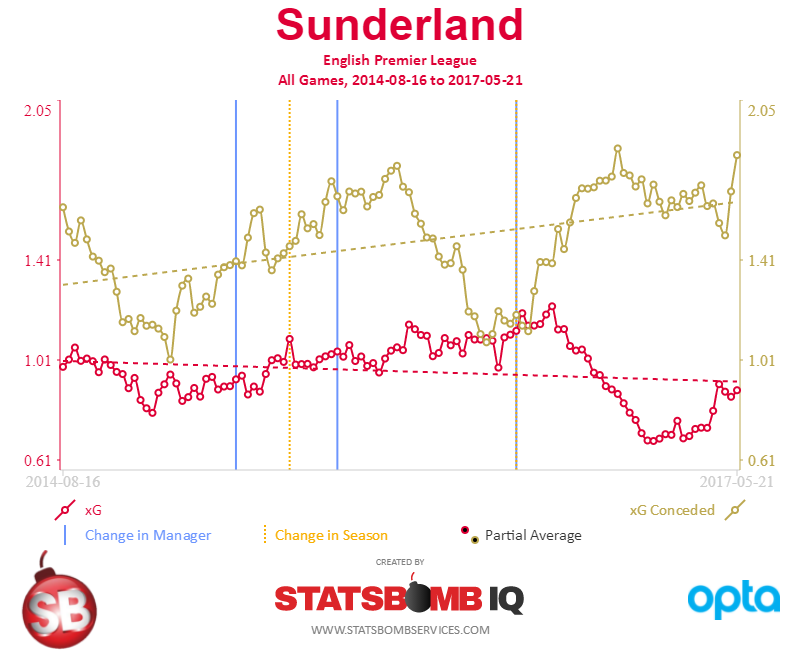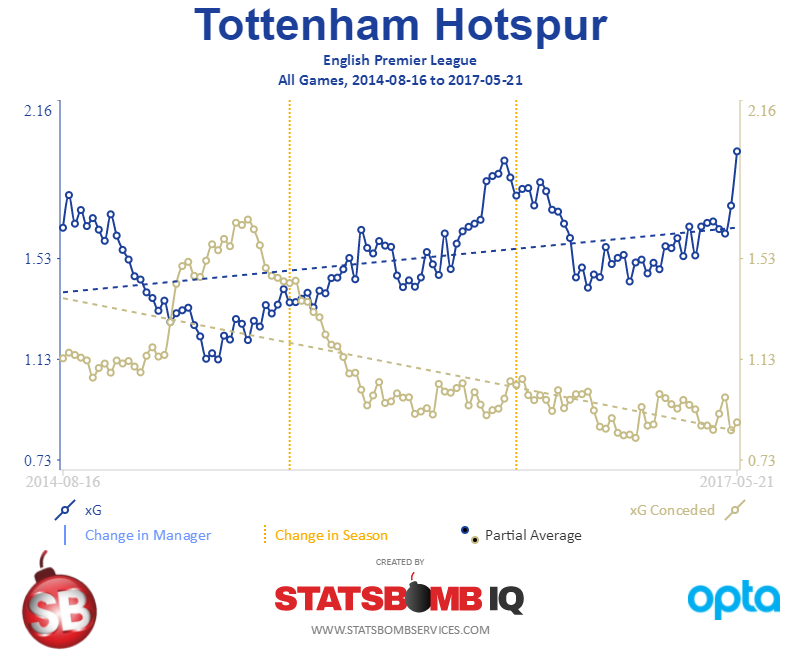One of the things we’ve been doing with StatsBomb IQ since we started is incorporating almost all the analysis tools that we use on a regular basis for teams and players into a simple, attractive interface.
Want to pull up radars of every player across your entire data set? We can do that.
Want shot maps with active filters for 34+ leagues? Already done.
A guided wizard that helps you choose your own metrics, including xGBuildup and our passing ability score, to find the best players to scout? It’s called IQ Scout and we released that early in the summer.
The new vis set we’re releasing this week is actually one of the simpler ones we’ve done but also one of the more powerful: trend lines. The wow factor here is less about the vis itself, but more about what you can do with them and why they are incredibly important.
Why Do I Care?  What you see above is Sunderland’s 3-year trend, with 15-game rolling averages. xG in attack is red and xG conceded is in gold.
What you see above is Sunderland’s 3-year trend, with 15-game rolling averages. xG in attack is red and xG conceded is in gold.
Why expected goals (or xG)? Because xG Difference is one of the stronger metrics in the public sphere for predicting future performance. There are plenty of other potential metrics to plot, and we will be incorporating them gradually, but at the team level xGD is something we really care about.
Plotting attack and defense here also gives you an idea of how the team is doing in each aspect of the game.
Now if you manage or own a football club, you want this information. You need this information. This information is one of the clearest indicators of how your club is performing currently and the long-term trending of team output. If I were Ellis Short (or Chief Football Officer Simon Wilson) looking at my team trends, I breathe a huge sigh of relief that Sam Allardyce finally managed to stabilise the team after years of teetering on the brink of relegation.
Then Allardyce goes to England and they need to find a new manager. On the surface, Moyes is a perfectly sensible hire. He speaks the language, knows the league, and did a great job at Everton.
Then you watch the trending and concern sets in. By mid-October, I would be worried that there is a problem. By late November, it’s clear that all the good work that Allardyce had done has been unwound. Our results haven’t been “unlucky” – we deserve to be at or near the bottom of the table. I am almost certainly looking for a new manager because it’s now clear that, if we perform like we have the rest of the season, we’re strongly likely to get relegated.
Sunderland were interesting because of the massive change in team performance compared to every other manager they had previously, but think about bad teams that had lucky starts in recent years that were clearly relegation candidates in the numbers. Paul Lambert’s horrible extension at Aston Villa comes to mind, as does the initial start of Hull under Mike Phelan. Making change early to avoid disaster, or reviewing objective data before extending a coach on a "lucky" run can save teams tens of millions of pounds.
Single game results can certainly be lucky. Long-term trends make real performance of the team much more obvious.
Meeting Team Goals
Obviously you care about this type of thing to make sure you aren’t getting relegated from the Premier League, but what about teams with clear aspirations, like clubs that have been recently relegated and are looking at automatic promotion?
Now we know that in order to try and guarantee promotion from the Championship, teams need to average a .75 xGD or better over the course of a season. Teams can and do go up with less, but if you are a yo-yo club that wants to make certain you go right back up, this is the goal you are aiming for.

This is Norwich City last season, on a 10-game rolling average. It’s clear at the ten-game mark that the performance isn’t really meeting the goals for the season and suddenly automatic promotion might be a long shot. That doesn’t mean you have to change head coach at that point, but you certainly want to take a closer look to figure out what the problems are and how to fix it. Though fairly basic, this type of information is crucial in running a football club.

Tottenham
What you see above is a 36-month plot of expected goals in attack (blue) and conceded (gold) with a 15-game rolling average to smooth everything out.
What’s interesting with Spurs is that this plot shows a) how rough that first season under Pochettino was – they were actually negative for a while in xGD, and the press was shambolic – and also how good they have been since. Poch’s teams seem to have a tendency to outperform normal xG metrics as it is, but even with that caveat, the trending is quite clear here.
Want to see just home or away performances? We’ve added easy filters for that as well.

Arsenal
There are so many interesting storylines around Arsenal in the last year, it’s almost hard to know where to start.

Here’s the one-year plot with 10-game rolling averages. Note the point where xG conceded actually ends up above xG in attack. In most big clubs, that’s a strong indicator that manager change is coming, but Arsenal is Arsenal and Wenger is back for another two seasons. I’m not saying he doesn’t deserve to stay – I’m just pointing out what happens almost everywhere else.
That particular dip in the trend is also interesting because it doesn’t exist in the previous 36 months and it coincides with the early part of the switch to a back 3. From an xG perspective, Arsenal’s April and early May was one of the worst in the data set. They were absolutely clubbed by Spurs and Palace, Boro lost but 55% of the time they win that one, and then Leicester and Man United were virtual standstills. The trend shot upward from late season trouncings of Sunderland, Stoke, and Everton, but despite a lot of spending recently, Arsenal look far from the ranks of an elite team.

Non-xG Trends
There are plenty of stats in football you might want to track, but the vis below shows one I think certain head coaches care about deeply.

The green line here is Defensive Distance, the purple one is Passes Per Defensive Action or PPDA. Both of these combine to make a fairly robust look at team pressing, which for some coaches is the lifeblood of both their attack and defense.
This is Bayer Leverkusen's output over the last three seasons, most of which was under Roger Schmidt. It's interesting to contrast the output of the first two seasons where they finished in Champions League places, and the final season where results went south and Schmidt eventually left.
At a coaching level, this provides a very clear data indicator of what is or is not working to use alongside your own eyes, which in turn probably helps dictate the agenda for what to work on in training. This is pure game model analysis. Data informed coaching is a useful next step in football tactics, and trend lines help in surfacing problems quickly. [Vis Note: Yes, there are two different Y-axes here. For good reason. Deal with it, Luke Bornn.]
Conclusion Trend lines aren't groundbreaking visualizations, but they are one of the most useful, powerful ways of displaying recent team performance across a wide array of metrics. If you run a football club and don't have access to this sort of information at your fingertips, you are missing an important piece of information on which to base decisions.
--Ted Knutson ted@statsbombservices.com @mixedknuts
[Credit note: Nat James, who did the early mockups for radars, did the programming and most of the design work on the trend lines vis. They will be available to StatsBomb IQ customers starting tomorrow.]
